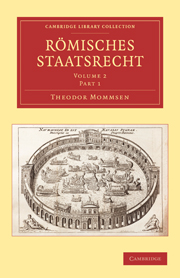Book contents
- Frontmatter
- Contents
- Das Königthum S. 3—15
- Die magistratische Befugniss des Oberpontifex S. 16—69
- Das Consulat S. 70—124
- Die Dictatur S. 125—153
- Das Reiterführeramt S. 156—164
- Der Consulartribunat S. 165—175
- Die Prätur S. 176—216
- Die Provinzialstatthalterschaft S. 217—246
- Der Volkstribunat S. 247—303
- Die Censur S. 304—442
- Die Aedilität S. 443—491
- Die Quästur S. 492—538
- Magistratische Offiziere S. 539—545
- Die magistratische Geschwornenleitung S. 546—555
- Der Vigintisex-, später Vigintivirat S. 556—571
- Ausserordentliche Beamte für die Reservatrechte der Gemeinde S. 572—600
- Ausserordentliche Aushülfsbeamte S. 601—637
- Die Senatsboten (legati) S. 638—661
- Die ausserordentlichen constituirenden Gewalten S. 662—697
Der Consulartribunat S. 165—175
Published online by Cambridge University Press: 29 August 2010
- Frontmatter
- Contents
- Das Königthum S. 3—15
- Die magistratische Befugniss des Oberpontifex S. 16—69
- Das Consulat S. 70—124
- Die Dictatur S. 125—153
- Das Reiterführeramt S. 156—164
- Der Consulartribunat S. 165—175
- Die Prätur S. 176—216
- Die Provinzialstatthalterschaft S. 217—246
- Der Volkstribunat S. 247—303
- Die Censur S. 304—442
- Die Aedilität S. 443—491
- Die Quästur S. 492—538
- Magistratische Offiziere S. 539—545
- Die magistratische Geschwornenleitung S. 546—555
- Der Vigintisex-, später Vigintivirat S. 556—571
- Ausserordentliche Beamte für die Reservatrechte der Gemeinde S. 572—600
- Ausserordentliche Aushülfsbeamte S. 601—637
- Die Senatsboten (legati) S. 638—661
- Die ausserordentlichen constituirenden Gewalten S. 662—697
Summary
Die Anknüpfung der consularischen Gewalt an den Militärtribunat ist eine Aushülfsmassregel für solche Fälle, wo die Kriegsverhältnisse es wünschenswerth machten mehr als zwei Oberbeamte aufzustellen; wie umgekehrt die Dictatur eine Aushülfsmassregel ist für den Fall, wo ein einheitliches Obercommando zweckmässig erscheint. Ob das Bedürfniss mehr als zwei Höchstcommandirende ins Feld zu senden gleich bei Einführung der Republik empfunden worden ist oder erst später sich aufgedrängt hat, vermögen wir nicht zu entscheiden. Von einem besonderen Gesetz, das diese Institution eingeführt hätte, weiss die römische Ueberlieferung nichts; und es kann wohl sein, dass der Militärtribunat mit consularischer Gewalt, wie die Dictatur, von Haus aus integrirender Bestandtheil der consularischen Verfassung gewesen ist. Indess ist es auch möglich, dass die ursprüngliche Verfassung erst späterhin sich in dieser Weise fortentwickelt hat und der Ursprung des Consulartribunats in der That in oder kurz vor das J. 310 zu setzen ist, unter welchem die Annalen die erste Anwendung davon melden. — Eine Ausnahme gegentlber der regelmässigen Wahl von zwei Oberbeamten war also der Consulartribunat wie die Dictatur; aber es war ein verfassungsmässig vorgesehenes und geordnetes Ausnahmeverfahren. Zu den ausserordentlichen Imperien im eigentlichen Sinn, das heisst denjenigen, die ihren Rechtsgrund in einem Specialgesetz haben, darf also dieser Kriegstribunat keineswegs gezählt werden. Die Entscheidung, ob dies Ausnahmeverfahren angewendet werden solle oder nicht, stand, eben wie bei der Dictatur, der Sache nach bei dem Senat, formell bei demjenigen Beamten, dem die Wahlleitung oblag.
- Type
- Chapter
- Information
- Römisches Staatsrecht , pp. 165 - 175Publisher: Cambridge University PressPrint publication year: 2010



